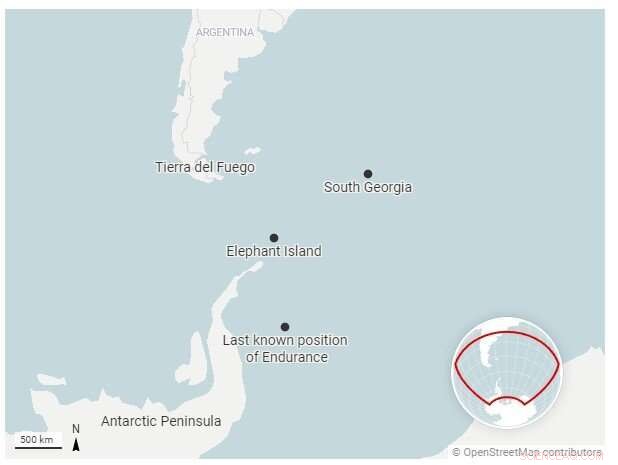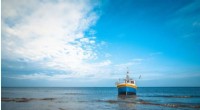
Wetenschap
Endurance-kapitein Frank Worsley, Shackletons begaafde navigator, wist hoe hij op koers moest blijven

Frank Worsley, de navigator van Ernest Shackleton, berekende zijn positie en zette koers om de hele bemanning te redden, ondanks ijskoude, winderige en doorweekte omstandigheden op kleine boten die in de Zuidelijke Oceaan woelen. Krediet:het gesprek
Toen het wrak van Ernest Shackleton's schip Endurance in maart 2022 bijna 10.000 voet onder het oppervlak van de Weddellzee van Antarctica werd gevonden, bevond het zich op slechts 6,4 km van zijn laatst bekende positie, zoals vastgelegd door de kapitein en navigator van de Endurance, Frank Worsley, in november 1915.
Dat is een verbazingwekkende mate van nauwkeurigheid voor een positie bepaald met mechanische gereedschappen, boeklengtetabellen met referentienummers en pen en papier.
De expeditie die naar het schip zocht, had een onderzees gebied van 150 vierkante mijl doorzocht - een cirkel van 14 mijl in doorsnee. Niemand wist hoe nauwkeurig Worsley's positieberekening was geweest, of hoe ver het schip had kunnen reizen tijdens het zinken.
Maar als historicus van Antarctische verkenning was ik niet verrast toen ik ontdekte hoe nauwkeurig Worsley was, en ik kan me voorstellen dat degenen die naar het wrak zochten dat ook niet waren.
Navigatie was de sleutel
De Endurance had Engeland in augustus 1914 verlaten, met de Ier Shackleton in de hoop de eerste te worden die het Antarctische continent van de ene naar de andere kant zou oversteken.
Maar ze zijn zelfs nooit op Antarctica geland. Het schip kwam in januari 1915 vast te zitten in zee-ijs in de Weddellzee en dwong de mannen van het schip in tenten die op de bevroren oceaan in de buurt waren geplaatst. De kracht van het ijs verpletterde de Endurance langzaam, liet hem 10 maanden later zinken en begon wat een ongelooflijke - en bijna ongelooflijke - saga van overleving en navigatie door Shackleton en zijn bemanning zou worden.
Shackletons eigen leiderschap is legendarisch geworden, net als zijn inzet om ervoor te zorgen dat er geen man verloren ging van de groep onder zijn bevel - hoewel drie leden van de 10-koppige groep van de expeditie in de Rosszee omkwamen.
Minder bekend is het belang van de navigatievaardigheden van de 42-jarige Worsley, een Nieuw-Zeelander die tientallen jaren in de Britse koopvaardij en de Royal Navy Reserve had doorgebracht. Zonder hem zou het verhaal van Shackletons overleving waarschijnlijk heel anders zijn geweest.
Markeertijd
Navigatie vereist het bepalen van de locatie van een schip in lengte- en breedtegraad. De breedtegraad is 's middags gemakkelijk te vinden vanuit de hoek van de zon boven de horizon.
De lengtegraad vereiste het vergelijken van de lokale middag - het moment waarop de zon op zijn hoogste punt stond - met de werkelijke tijd op een andere locatie waar de lengtegraad al bekend was. De sleutel was ervoor te zorgen dat de tijdmeting voor die andere locatie nauwkeurig was.
Het maken van deze astronomische waarnemingen en het doen van de daaruit voortvloeiende berekeningen was op het land al moeilijk genoeg. Op de oceaan, met weinig vaste landpunten zichtbaar, te midden van slecht weer, was het bijna onmogelijk.
Navigatie was dus grotendeels afhankelijk van 'gegist bestek'. Dit was het proces van het berekenen van de positie van een schip met behulp van een eerder bepaalde positie en het opnemen van schattingen van hoe snel en in welke richting het schip bewoog. Worsley noemde het 'de zeemansberekening van koers en afstand'.
Op zoek naar land
When the Endurance was crushed, the crew had to get themselves to safety, or die on an ice floe adrift somewhere in the Southern Ocean. In April 1916, six months after the Endurance sank, the sea ice on which they had camped began to break up. The 28 men and their remaining gear and supplies loaded into three lifeboats—the James Caird, Dudley Docker and Stancomb Wills—each named for major donors to the expedition.
Worsley was in charge of getting them to land. As the journey began, Shackleton "saw Worsley, as navigating officer, balancing himself on the gunwale of the Dudley Docker with his arm around the mast, ready to snap the sun. He got his observation and we waited eagerly while he worked out the sight."
To do that, he compared his measurement with the time on his chronometer and written tables of calculations.
And so began one of the most remarkable rescue missions in history. In a small open lifeboat, six men sailed 800 miles across some of the roughest seas on the planet to get help. We think they navigated with these instruments, on display in #PolarWorlds pic.twitter.com/4lxgzfR1BL
— Dr. Claire Warrior (@ClaireWarrior1) March 9, 2022
A last hope of survival
Once they managed to arrive on a little rocky strip called Elephant Island, off the coast of the Antarctic Peninsula, they still faced starvation. Shackleton believed that the only hope of survival lay in fetching help from elsewhere.
Worsley was ready. Before the Endurance was crushed, he had "worked out the courses and distances from the South Orkneys to South Georgia, the Falklands and Cape Horn, respectively, and from Elephant Island to the same places," he recalled in his memoir.
The men used parts of the other lifeboats to reinforce the James Caird for a long sea journey. Every day, Worsley "watched closely for the sun or stars to appear, to correct my chronometer, on the accuracy of which our lives and the success of the journey would depend."
On April 24, 1916, Worsley got "The first sunny day with a clear enough horizon to get a sight for rating my chronometer." That same day, he, Shackleton and four other men set off under sail in the 22.5-foot James Caird, carrying Worsley's chronometer, navigational books and two sextants, used for fixing the position of the Sun and stars.
The boat journey
These men, in this tiny boat, were going from one pinpoint of rock in the Southern Ocean to another, facing high winds, massive currents and choppy waters that could push them wildly astray or even sink them. The success of this voyage depended on Worsley's absolute accuracy, based on observations and estimations he made in the worst possible environmental conditions, while sleep-deprived and frostbitten.
They spent 16 days of "supreme strife amid heaving waters," as the boat sailed through some of the most dangerous sea conditions in the world, experiencing "mountainous" swells, rain, snow, sleet and hail. During that time, Worsley was able to get just four solid fixes on the boat's position. The rest was "a merry jest of guesswork" to determine where the wind and waves had taken them, and adjusting the steering accordingly.
The stakes were enormous—if he missed South Georgia, the next land was South Africa, 3,000 miles farther across more open ocean.
As Worsley wrote later:"Navigation is an art, but words fail to give my efforts a correct name. … Once, perhaps twice, a week the sun smiled a sudden wintry flicker, through storm-torn cloud. If ready for it, and smart, I caught it. The procedure was:I peered out from our burrow—precious sextant cuddled under my chest to prevent seas from falling on it. Sir Ernest stood by under the canvas with chronometer, pencil, and book. I shouted "Stand by," and knelt on the thwart—two men holding me up on either side. I brought the sun down to where the horizon ought to be and as the boat leaped frantically upward on the crest of a wave, snapped a good guess at the altitude and yelled "Stop." Sir Ernest took the time and I worked out the result. Then the fun started! Our fingers were so cold that he had to interpret his wobbly figures—my own so illegible that I had to recognize them by feats of memory."
On May 8, they saw floating seaweed and birds, and then spotted land. But they had arrived at South Georgia amid a hurricane, and for two days had to fight being driven by wind onto an island they had spent weeks desperately trying to reach.
Finally, they came ashore. Three of the six men, including Worsley, hiked across unmapped mountains and glaciers to reach a small settlement. Worsley joined a rescue boat back to get the other three. Shackleton later arranged a ship to collect the rest of the men from Elephant Island, all of whom had survived their own unimaginable hardships.
But the key to all of it, and indeed the recent discovery of the Endurance's wreck, was how Worsley had fought desperate conditions and still repeatedly managed to figure out where they were, where they were going and how to get there.
 Klimaatverandering beïnvloedt bodemgezondheid
Klimaatverandering beïnvloedt bodemgezondheid Oost-Afrika wankelt van dodelijke overstromingen bij extreem weer
Oost-Afrika wankelt van dodelijke overstromingen bij extreem weer Wetenschappers stellen voor om de regels van de geschiedenis te veranderen om de ineenstorting van het milieu te voorkomen
Wetenschappers stellen voor om de regels van de geschiedenis te veranderen om de ineenstorting van het milieu te voorkomen Waarom zijn Jaguars bedreigde dieren?
Waarom zijn Jaguars bedreigde dieren?  Informatie over de Polar Zone
Informatie over de Polar Zone
Hoofdlijnen
- Wat gebeurt er op een microscopisch niveau tijdens homeostase?
- De nacht zit vol met dieren, maar wetenschappers weten er heel weinig van
- In stedelijke stromen, farmaceutische vervuiling stimuleert microbiële resistentie
- Wat is de rol van glucose in het lichaam?
- Wat zijn de verschillen tussen een plant en een dierlijke cel onder een microscoop?
- De oudste kleur van de aarde was roze
- De toekomst van gewastechniek
- Wat levert glycolyse op?
- Robotapparaat volgt plantengroei op cellulair niveau
- NJIT-professor wiskundige wetenschappen publiceert voorspellingen voor Major League Baseball

- Federale subsidies voor commerciële visserij in de VS moeten worden afgewezen:analyse

- Hoe historisch racisme de moderne armoede en raciale ongelijkheid beïnvloedt

- Waarom traumagevoelig lesgeven er nog meer toe doet in 2021

- Politiek panelonderzoek:Duitsers voelen zich sterk bedreigd door de huidige crises

 10 eenvoudige wetenschapsprojecten
10 eenvoudige wetenschapsprojecten  Sites zoals Facebook, Google en Twitter lieten blanke supremacisten floreren. Wat nu?
Sites zoals Facebook, Google en Twitter lieten blanke supremacisten floreren. Wat nu? Het stapelen van 2D-materialen levert verrassende resultaten op
Het stapelen van 2D-materialen levert verrassende resultaten op Bessel,
Bessel,  Clathrin als biotech-substraat:immobilisatie en functionalisering
Clathrin als biotech-substraat:immobilisatie en functionalisering Baanbrekend onderzoek maakt 3D-geprinte chocolade mogelijk zonder temperatuurregeling
Baanbrekend onderzoek maakt 3D-geprinte chocolade mogelijk zonder temperatuurregeling Google brengt camerawendingen, grotere schermen naar Pixel-telefoons (update)
Google brengt camerawendingen, grotere schermen naar Pixel-telefoons (update) Radiorelikwie ontdekt in een nabijgelegen cluster van sterrenstelsels
Radiorelikwie ontdekt in een nabijgelegen cluster van sterrenstelsels
- Elektronica
- Biologie
- Zonsverduistering
- Wiskunde
- French | Italian | Spanish | Portuguese | Swedish | German | Dutch | Danish | Norway |

-
Wetenschap © https://nl.scienceaq.com

